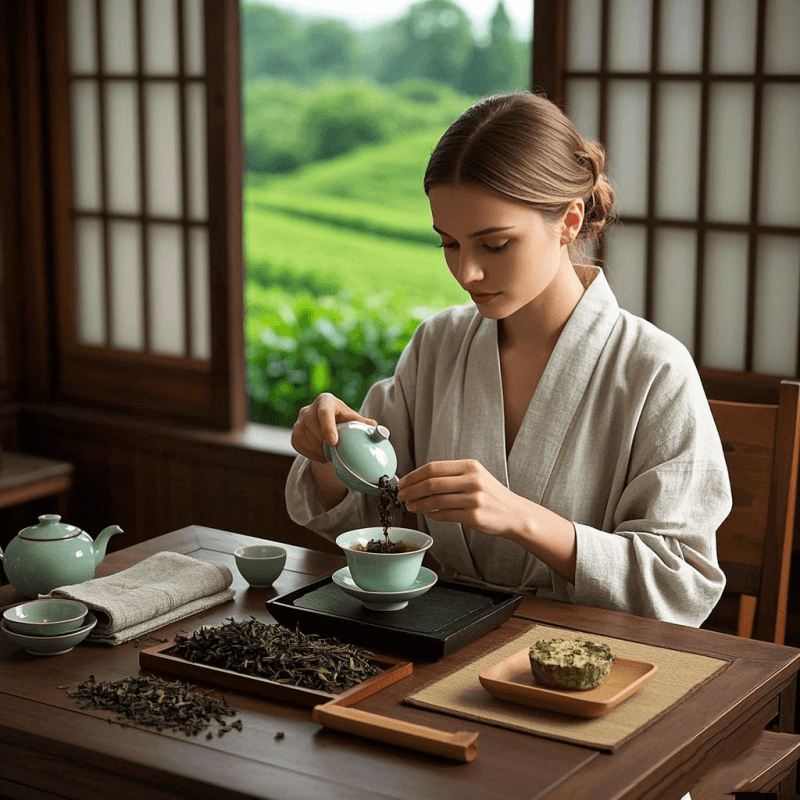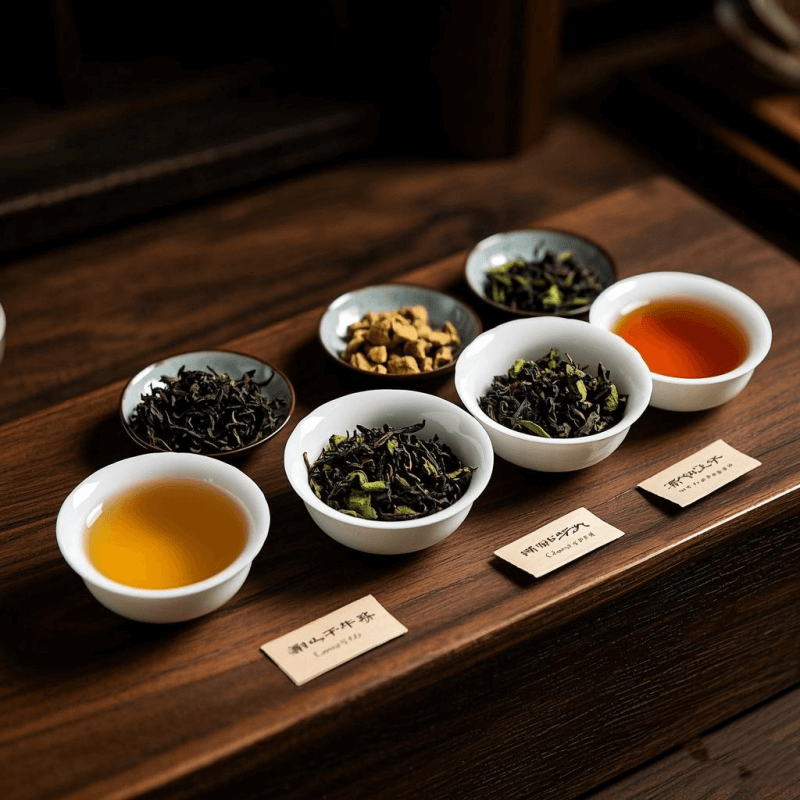1. Introduction: Why Knowing the Types of Oolong Tea Matters

For tea lovers, few beverages offer the diversity of oolong tea. Unlike green tea’s bright simplicity or black tea’s robust intensity, oolong exists in a delicious middle ground—one shaped by oxidation, terroir, and tradition. But to truly appreciate its range, you need to understand the types of oolong tea available.
Choosing the right oolong can transform your tea ritual: a floral Tie Guan Yin might brighten your morning, while a roasted Da Hong Pao could cozy up your evening. With so many varieties, from light and fragrant to rich and toasty, knowing their differences helps you find your perfect match. Let’s dive into the world of oolong tea and uncover why its diversity is part of its magic.
2. The Uniqueness of Oolong Tea: Oxidation and Craft
What makes oolong tea so versatile? Its defining feature is semi-oxidation—a process where tea leaves are exposed to air, changing their color, flavor, and aroma. Unlike green tea (0–10% oxidation) or black tea (80–100% oxidation), oolong falls somewhere in between: 10–80% oxidation, depending on the type.
This flexibility is why the types of oolong tea vary so dramatically. Oxidation isn’t just a science—it’s an art. Tea masters control it by tossing leaves to bruise edges, then resting them to trigger chemical changes. Less oxidation preserves bright, floral notes; more creates deeper, fruitier or roasted flavors.
Processing steps like rolling and roasting further shape each type:
- Light rolling: Produces loose, curly leaves that infuse quickly with fresh flavors.
- Tight rolling: Creates compact balls that unfurl during brewing, releasing layers of flavor.
- Charcoal roasting: Adds smoky, caramelized depth (common in darker varieties).
It’s this combination of oxidation and craft that makes the types of oolong tea so distinct—and so exciting to explore.
3. Key Types of Oolong Tea: From Floral to Roasted
The types of oolong tea can be broadly categorized by their oxidation level and flavor profiles, ranging from light and fragrant to rich and toasty. Here are the most popular varieties every tea lover should know:
🌸 Lightly Oxidized (10–30%): Floral & Fresh
- Tie Guan Yin (Iron Goddess of Mercy): Hailing from Fujian, China, this is one of the most iconic types of oolong tea. With delicate orchid aromas and a buttery finish, it’s lightly oxidized and often unroasted. High-quality versions (called “Anxi Tie Guan Yin”) offer bright green hues and a refreshing, almost sweet taste.
- Alishan Oolong: Grown in Taiwan’s Alishan Mountains ( 1,000–1,800m), this tea boasts creamy, milky notes with hints of peach. Its light oxidation and high altitude slow growth create tender leaves with concentrated sweetness.
🍂 Medium Oxidized (30–60%): Fruity & Balanced
- Da Hong Pao (Big Red Robe): A Fujian classic from the Wuyi Mountains, this oolong has a rich, fruity flavor with chocolate and stone fruit undertones. Medium oxidation and gentle roasting give it a smooth, velvety texture that lingers on the palate.
- Dong Ding Oolong: Taiwan’s beloved “Frozen Summit” tea offers nutty, caramel notes with a hint of floral brightness. Its balanced oxidation makes it versatile—great for both new and seasoned oolong drinkers.
🌰 Highly Oxidized (60–80%): Roasted & Complex

- Shui Xian (Water Sprite): Another Wuyi gem, this oolong is often heavily roasted, resulting in smoky, earthy flavors with dried fruit sweetness. It’s bold enough to stand up to milk (though purists prefer it plain) and ages beautifully over time.
- Roasted Tie Guan Yin: A darker twist on the classic, this version undergoes charcoal roasting, transforming its floral notes into warm caramel and toffee. It’s perfect for cold days or those who prefer deeper, more robust teas.
Discover our handpicked types of oolong tea from China and Taiwan to taste these distinct profiles firsthand.
4. Oolong Tea by Region: Taiwan vs. Mainland China
Geography plays a huge role in shaping the types of oolong tea. While both Taiwan and mainland China produce exceptional oolong, their styles reflect local traditions and terroir.
🇹🇼 Taiwanese Oolong: Focus on Freshness & Aroma
Taiwan’s mountainous terrain (with peaks up to 3,952m) and cool climates create ideal conditions for oolong. Taiwanese farmers prioritize light oxidation and minimal roasting to highlight natural flavors:
- Mountain Oolongs: Grown above 1,000m (e.g., Alishan, Yu Shan), these teas develop sweet, creamy notes from slow growth and misty conditions.
- Processing: Emphasis on hand-rolling and precise oxidation control, resulting in teas with bright clarity and floral/fruity profiles.
🇨🇳 Mainland Chinese Oolong: Tradition & Depth
China’s oolong heritage spans centuries, with regions like Fujian and Guangdong perfecting distinct styles:
- Fujian: Home to Tie Guan Yin (Anxi) and Wuyi Dancong teas, known for either floral brightness or roasted complexity.
- Guangdong: Famous for Phoenix Oolong (Fenghuang Dancong), single-bush teas with unique aromas like lychee and honey.
- Processing: Often includes charcoal roasting, a technique dating back to the Ming Dynasty, which adds depth and longevity to the tea.
Both regions offer incredible diversity—whether you prefer Taiwan’s crisp elegance or China’s rich tradition, the types of oolong tea cater to every preference.
5. How to Choose Your Perfect Type of Oolong Tea
With so many types of oolong tea, finding your favorite starts with understanding your flavor preferences. Use this guide to narrow down your choices:
✨ If You Like Floral, Fresh Flavors
Opt for lightly oxidized varieties:
- Try Tie Guan Yin or Alishan Oolong.
- Look for terms like “unroasted,” “green oolong,” or “spring harvest” (younger leaves = brighter flavor).
🍑 If You Prefer Fruity, Balanced Notes
Medium oxidized oolongs are your match:
- Dong Ding or Da Hong Pao offer stone fruit and caramel hints.
- These pair well with food, making them great for afternoon tea.
🌰 If You Love Rich, Roasted Profiles
Go for highly oxidized, roasted types:
- Roasted Tie Guan Yin or Shui Xian deliver smoky, toasty depth.
- They’re ideal for sipping alone, especially in cooler weather.
🧪 Pro Tip: Start with a sampler pack! Many tea shops offer assortments of types of oolong tea, letting you taste-test before committing to a full bag. Shop a wide variety of oolong tea to match your flavor preferences and experiment until you find your go-to.
6. Tea Lover Reviews: Most Beloved Oolong Types
Don’t just take our word for it—here’s what tea enthusiasts say about their favorite types of oolong tea:
- “Alishan Oolong changed my morning routine! Its milky sweetness is so smooth, I’ve stopped adding honey. It’s now my ‘happy start’ ritual.” — Sarah L., tea blogger
- “Da Hong Pao is my evening comfort. The roasted fruit notes feel like a warm hug after a long day. I steep it 3–4 times, and each cup gets better.” — James K., frequent customer
- “Tie Guan Yin’s orchid aroma is intoxicating. I love how it wakes up my senses without the jitters of coffee. Perfect for workdays!” — Mei T., tea club member
As Teavivre notes, “The beauty of oolong is its adaptability—there’s truly a variety for every mood and moment.”
7. Conclusion: Embrace the Diversity of Oolong Tea
The types of oolong tea are a testament to tea’s endless creativity. From floral, cloud-kissed Taiwanese mountain oolongs to rich, roasted Wuyi classics, each variety tells a story of terroir, tradition, and craft.
Understanding these types isn’t just about knowledge—it’s about connection: to the farmers who tend ancient bushes, to the artisans who master oxidation, and to the rituals that make tea more than a drink. Whether you’re a or a seasoned connoisseur, there’s always a new oolong to discover.
Learn how to identify types of oolong tea by taste and origin to deepen your appreciation, and let each cup introduce you to a new corner of this wonderful tea world. After all, the perfect oolong isn’t just found—it’s experienced.
Explore the diverse types of oolong tea—from floral Taiwanese varieties to roasted Chinese classics. Find your perfect oolong tea match with our guide to flavors, origins, and picks.

Pingback: Oolong Teas Tea Types: Explore Unique Flavors from Tieguanyin to Alishan